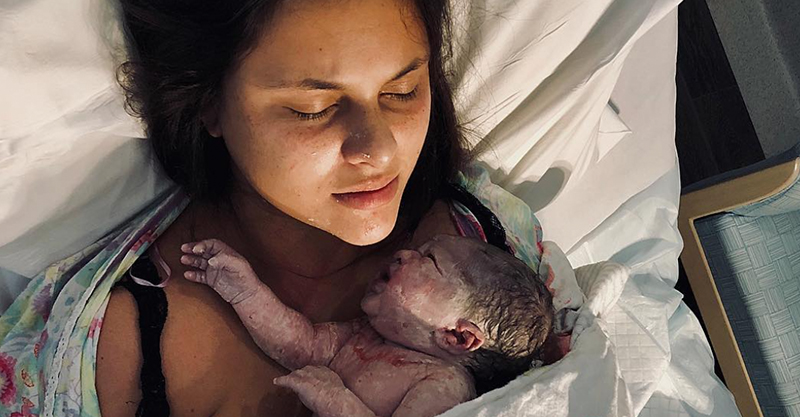Transition time: New mum shares perfect description of final stages of labour

Queensland mum Danielle Correya has just welcomed her second baby, and some reflections on the final stages of labour have got other mums nodding – and crossing their legs – with familiar ouchy feels.
Second time’s a charm?
“I birthed naturally again without drugs … though I found it so much more intense,” Danielle wrote on Instagram, sharing an exhausted and gorgeous postpartum image of herself with newborn baby, India.
India was born on Friday, and Danielle says that even though she’d already birthed a baby – India’s big brother, Jed – the sheer force of those final hours of labour really caught her by surprise.
“The last two hours of contractions felt like I was getting ripped apart, the last half hour felt like my body was breaking, each contraction was like nothing I’ve ever experienced.”
Read more about birth:
- Why emergency c-sections happen and what to expect if it happens to you
- Kids at their sibling’s birth: “Crazy or a wonderful thing to do?”
- Hero mum shares real life look at what growing triplets does to your body
“I can’t do this anymore”
A recovering Danielle, obviously besotted with her tiny girl, shared a quote attributed to doula Lisa Hart which captured how overwhelming and primal this ‘transition’ stage can be.
“One thing I have witnessed, and always loved about birth, is that birth will take you to your limits and then take you over them. When a birthing woman is nearly 7/8 centimetres, characteristically known as transitioning, she will undoubtedly say, think or feel ‘I can’t do this anymore’.”
“Often time the feeling will manifest itself into those words, a moment of crying, a feeling of wanting to flee or a frantic look. It’s when she begins to feel the birth has become stronger than her … However, it is at this moment something magical happens. The woman ‘is’ the birth, and at this moment she digs down deep and finds that strength she never knew she had.”
Transition and transformation
When things feel at their toughest, a transformation begins and it preps women for the challenging days and years that lie ahead.
“There is a surge of hormones that cascade through her body, adrenaline and oxytocin, and within a few contractions her body spontaneously begins pushing and she finishes the work that is needed to bring her baby. She has just proven herself to herself.”
“Often times the expression is “I did it” or “I can’t believe I just did that”. Yes, you did that mama, that strength and power was you. What you have now is an empowered mother, ready to meet the demands of motherhood.”
Indeed. Wow. A huge congratulations to Danielle, Jarred and Jed on the birth of baby India (and a big thank you for sharing a little more about your birth. Speedy recovery to you!)
What is the transition stage of labour?
During the transition stage of labour, the cervix dilates from 8 centimetres to a fully dilated 10 centimetres.
Contractions usually become more intense, painful and frequent, often relentlessly running into each other.
The desire to ‘give up’ or feelings of being unable to give birth can be overwhelming for the labouring woman, as the baby’s head moves down the birth canal, pain increases and delivery approaches.
Some women feel an intense urge to push during this phase of labour, but it’s not the time to push yet because the cervix is still in the process of dilating.
Women may feel shaky, clammy, confused during transition. Many women become really vocal, grunting, moaning, wailing or crying out during this phase.









